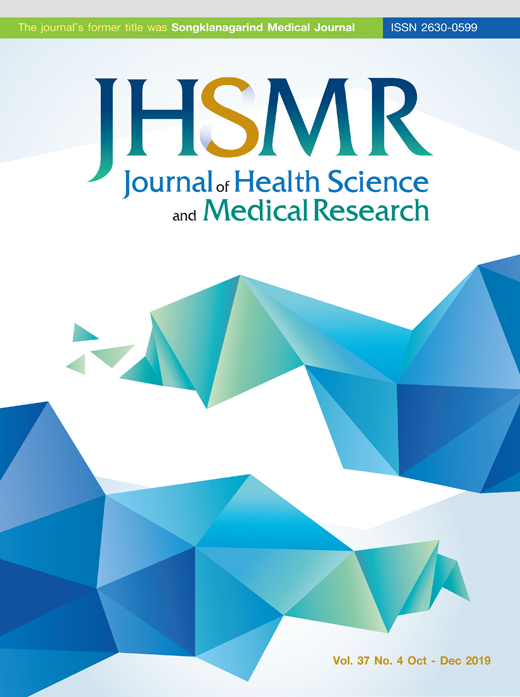Prevalence of Antibiotic Resistance in Escherichia coli from the Fecal Flora of Humans in a Rural Area of Songkhla Province
DOI:
https://doi.org/10.31584/jhsmr.201967Keywords:
antibiotic, drug resistance, Escherichia coli, prevalence, rural areaAbstract
Objective: To determine the prevalence of antibiotic resistance in fecal Escherichia coli (E. coli ) isolated from humans in a rural area of Songkhla province.
Meterial and Methods: E. coli strains were isolated from the stool cultures of 75 healthy volunteers in a rural area. Resistance rates for 8 antibiotics were determined.
Results: The resistance rates for amoxicillin, doxycyclin, cotrimoxazole, gentamicin and cefazolin were 53.3, 51.3, 24.0, 5.3 and 3.3%, respectively. No resistance to norfloxacin, ceftriaxone, and imipenem were detected.
Conclusion: The most prevalent resistant strains were found against amoxicillin. The prevalence of drug resistance in all multidrug resistant isolates were resistant to amoxicillin and doxycycline. No strains were resistant to all antibiotics in all antimicrobial categories as all the strains were found to be sensitive to ceftriazone, norfloxacin and imipenem.
References
2. Phumart P, Phodha T, Thamlikitkul V, Riewpaiboon A, Prakongsai P, Limwattananon S. Health and economic impacts of antimicrobial resistance in Thailand. J Health Systems Res 2012;6:352-60.
3. Cosgrove SE. The relationship between antimicrobial resistance and patient outcomes: mortality, length of hospital stay, and health care costs. Clin Infect Dis 2006;42(Suppl 2):S82-9.
4. Lautenbach E, Patel JB, Bilker WB, Edelstein PH, Fishman NO. Extended-spectrum beta-lactamase-producing Escherichia coli and Klebsiella pneumoniae: risk factors for infection and impact of resistance on outcomes. Clin Infect Dis 2001;32:1162-71.
5. Prestinaci F, Pezzotti P, Pantosti A. Antimicrocial resistance: a global multifaceted phenomenon. Pathog Glob Health 2015;109:309-18.
6. World Health Organization. on surveillance: antibiotic resistance [monograph on the Internet]. Geneva: WHO; 2014 [cited 2017 Oct 26]. Available from: http://Geneva,who.int/iris/bitstream/10665/112642/1/9789241564748_eng.pdf
7. Daniel WW. Biostatistics: a foundation for analysis in the health Sciences. 9th ed. New York: John Wiley & Sons 2019;189-214.
8. Jean B, Franklin R, Jeff A, Patricia A, George M, Dwight J. Performance standards for antimicrobial susceptibility testing; twenty-fourth informational supplement. Clin Lab Standards Ins 2014;24:62-67.
9. Jamulitrat S, Promplook S, Varindsathien P. Antibiotic resistance pattern of Escherichia coli isolated from fecal flora of human in rural area, J infect Dis Antimicrob Agents 1998;5:6-8.
10. Antibiotic resistance: drug resistance, antimicrobial resistance [monograph on the Internet]. Florida: Infectious Disease Health Center; 2016 [cited 2016 Jul 10]. Available from: https://www. medicinenet.com/antibiotic_resistance/article.htm#the_history_of_antimicrobial_drug_resistance
11. Nys S, Okeke I, Kariuki S, Dinant G, Driessen C, Stobberingh E. Antibiotic resistance of faecal Escherichia coli from healthy volunteers from eight developing countries. J Antimicrob Chem 2004;54:952-5.
12. Wuttananupan K. Antibiotic resistance pattern and resistance genes of Escherichia coli isolates from human stool samples [Dissertation]. Songkhla: Prince of Songkla University; 2006.
13. Cho S, Lim Y, Park M, Kim S, Kang Y. Prevalence of antibiotic resistance in Escherichia coli fecal isolates from healthy persons and patients with diarrhea. Public Health Res Perspect 2011;2:41-5.
14. Shin H, Cho S. Prevalence of antimicrobial resistance in Escherichia coli strains isolated from fishery workers, Osong Public Health Res Perspect 2013;4:72-5.
15. Adugna A, Kibret M, Abera B, Nibret E, Adal M, Antibiogram of E. coli serotypes isolated from children aged under five with acute diarrhea in Bahir Dar town. Afr Health Sci 2015;15:656-64.
16. Sekar R, Mythreyee M, Srivani S, Amudhana M. Prevalence of antimicrobial resistance Klebsiella spp. in rural South India. J Glob Antimicrob Res 2016;5:80-5.
17. Desta K, Woldeamanuel Y, Azazh A. High gastrointestinal colonization rate with extended-spectrum β-lactamase producing Enterobacteriaceae in hospitalized patients: emergence of carbapenemase-producing K. pneumoniae in Ethiopia. PLoS ONE 2016;11:54-64.
18. Beyene G, Tsegaye W. Bacterial uropathogens in urinary tract infection and antibiotic susceptibility pattern in Jimma University specialized hospital, southwest Ethiopia. Ethiop J Health Sci 2011;21:61-5.
19. Demilie T, Beyene G, Melaku S, Tsegaye W. Urinary bacterial profile and antibiotic susceptibility pattern among pregnant women in north west Ethiopia. Ethiop J Health Sci 2012;22:121-8.
20. Abejew A, Denboba A, Mekonnen A. Prevalence and antibiotic resistance pattern of urinary tract bacterial infections in Dessiearea, Northeast Ethiopia. BMC Res Notes 2014;7:687-8.
21. Tiruneh M, Yifru S, Gizachew M. Changing trends in prevalence and antibiotics resistance of uropathogens in patients attending the Gondar University Hospital, Northwest Ethiopia. Int J Bacteriol 2014;14:1-7.
22. Eshetie S, Tarekegn F, Kumera G, Mekonnen F. Multidrug resistant Escherichia coli strains isolated from urine sample, University of Gondar Hospital, Northwest Ethiopia. J Coastal Life Med 2016;4:140-2.
23. Derbie A, Hailu D, Mekonnen D, Abera B, Yitayew G. Antibiogram profile of uropathogens isolated at Bahir Dar regional health research laboratory centre, northwest Ethiopia. Pan Afr Med J 2017;26:134.
24. Dereje M, Woldeamanuel Y, Asrat D, Ayenachew F. Urinary tract infection among fistula patients admitted at Hamlin fi stula hospital, Addis Ababa, Ethiopia. BMC Infect Dis 2017;17:150.
25. Wondimeneh Y, Muluye D, Alemu A. Urinary tract infection among obstetric fistula patients at Gondar University Hospital, Northwest Ethiopia. BMC Womens Health 2014;14:12.
26. Wasihun A, Wlekidan L, Gebremariam S. Bacteriological profile and antimicrobial susceptibility patterns of blood culture isolates among febrile patients in Mekelle hospital, Northern Ethiopia. Springerplus 2015;4:1.
27. Mulu W, Abera B, Yimer M, Hailu T, Ayele H, Abate D. Bacterial agents and antibiotic resistance profiles of infections from different sites that occurred among patients at Debre Markos Referral Hospital, Ethiopia: a cross sectional study. BMC Res Notes 2017;10:254.
28. Richard J, Yitzhak T. Antibiotics and bacterial resistance in the 21st Century. Perspect Med Chem 2014;6:25-64.
29. Hart A, Kariuki S. Antimicrobial resistance in developing countries. BMJ 1998;317:647-50.
30. Zamen S, Hussain M, Nye R, Mehta V, Mamun K, Hossain N. A review on antibiotic resistance: Alarm bells are ringing. Cureus 2017;9:1-9.
31. Songklanagarind Hospital. Nursing Services Division. Statistics of wards in 2018. Songkhla: The Hospital; 2018.
























